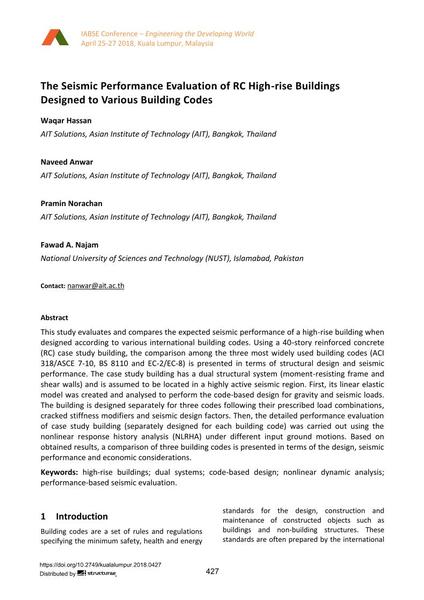The Seismic Performance Evaluation of RC High-rise Buildings Designed to Various Building Codes

|
|
|||||||||||
Bibliographic Details
| Author(s): |
Waqar Hassan
(AIT Solutions, Asian Institute of Technology (AIT), Bangkok, Thailand)
Naveed Anwar (AIT Solutions, Asian Institute of Technology (AIT), Bangkok, Thailand) Pramin Norachan (AIT Solutions, Asian Institute of Technology (AIT), Bangkok, Thailand) Fawad A. Najam (National University of Sciences and Technology (NUST), Islamabad, Pakistan) |
||||
|---|---|---|---|---|---|
| Medium: | conference paper | ||||
| Language(s): | English | ||||
| Conference: | IABSE Conference: Engineering the Developing World, Kuala Lumpur, Malaysia, 25-27 April 2018 | ||||
| Published in: | IABSE Conference Kuala Lumpur 2018 | ||||
|
|||||
| Page(s): | 427-434 | ||||
| Total no. of pages: | 8 | ||||
| DOI: | 10.2749/kualalumpur.2018.0427 | ||||
| Abstract: |
This study evaluates and compares the expected seismic performance of a high-rise building when designed according to various international building codes. Using a 40-story reinforced concrete (RC) case study building, the comparison among the three most widely used building codes (ACI 318/ASCE 7-10, BS 8110 and EC-2/EC-8) is presented in terms of structural design and seismic performance. The case study building has a dual structural system (moment-resisting frame and shear walls) and is assumed to be located in a highly active seismic region. First, its linear elastic model was created and analysed to perform the code-based design for gravity and seismic loads. The building is designed separately for three codes following their prescribed load combinations, cracked stiffness modifiers and seismic design factors. Then, the detailed performance evaluation of case study building (separately designed for each building code) was carried out using the nonlinear response history analysis (NLRHA) under different input ground motions. Based on obtained results, a comparison of three building codes is presented in terms of the design, seismic performance and economic considerations. |
||||
| Keywords: |
high-rise buildings non-linear dynamic analysis dual systems code-based design performance-based seismic evaluation
|
||||
